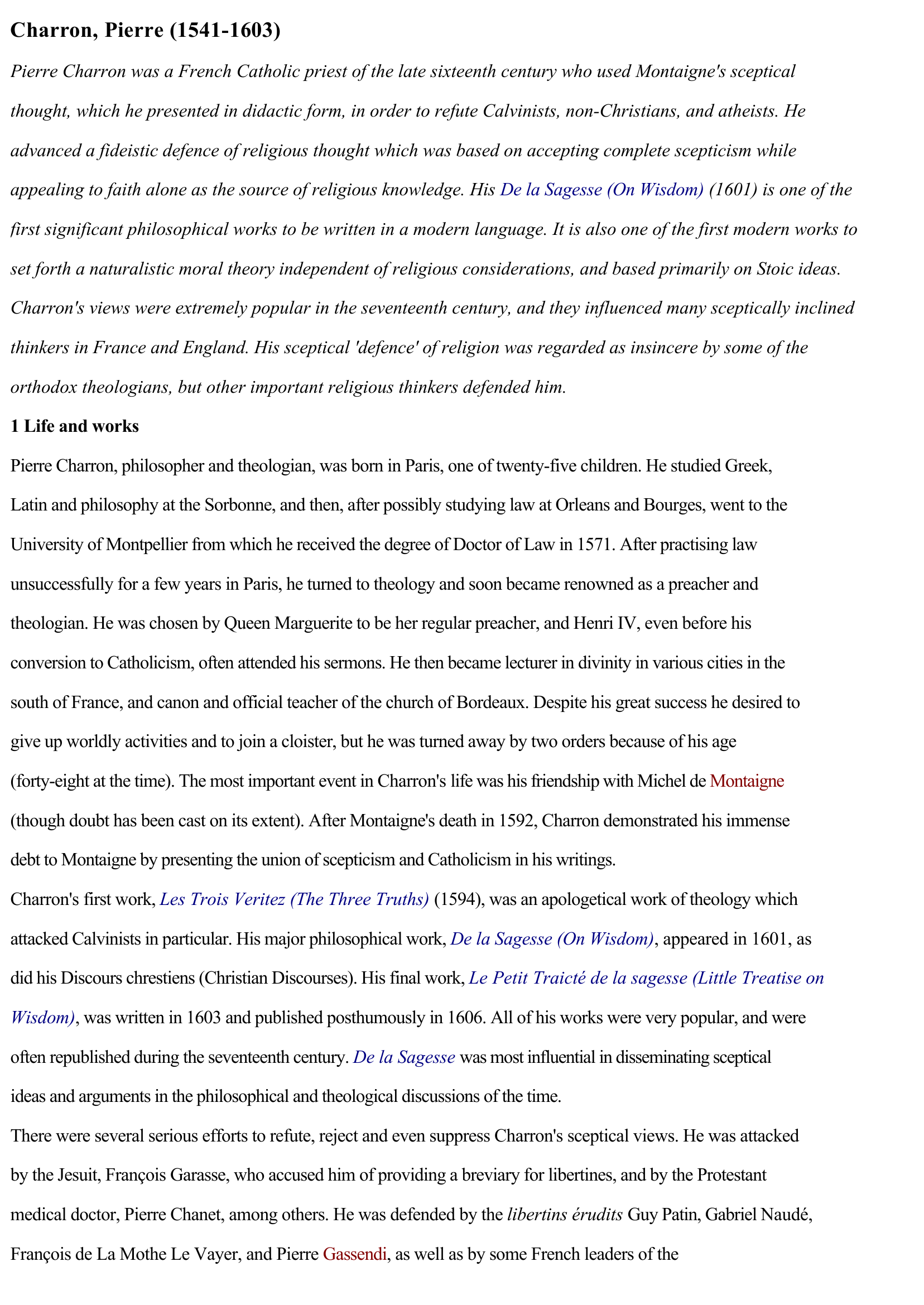CHARRON Pierre : sa vie et son oeuvre
Publié le 20/11/2018

Extrait du document
CHARRON Pierre (1541-1603). Né à Paris dans une famille de libraires peu fortunée mais ouverte aux choses de l’esprit, il fit de brillantes études de lettres et de philosophie, puis étudia le droit à Montpellier et se consacra quelques années au barreau. Dans le même temps, il entra dans les ordres et commença une carrière
de prédicateur religieux qui finit par l’occuper tout entier : Marguerite de Navarre l’attacha à sa maison comme prédicateur ordinaire, et plusieurs évêques de Gascogne et de Languedoc le firent venir comme théologal, ou prédicateur extraordinaire.
En 1576, il s'installa à Bordeaux où il venait d'être nommé chanoine. Il y rencontra Montaigne et devint son émule fervent. En 1601, depuis un an théologal de Condom, il publia à Bordeaux la première édition de son œuvre la plus célèbre, De la sagesse. Lors d'un court séjour à Paris pour préparer une réédition édulcorée de l'ouvrage, il mourut brutalement, frappé d'apoplexie en pleine rue.
Charron, dans ses premières œuvres, cherche à faire passer avant tout sa conviction profonde de prédicateur catholique : celle de la supériorité de l'Église catholique romaine sur toutes les hérésies, et plus particulièrement sur l'hérésie protestante. Il publie à cet effet, en 1593, les Trois Vérités contre les athées... L’ouvrage se veut un manuel d’orthodoxie clairement dirigé contre les pamphlétaires de la Ligue, et surtout contre Duplessis-Mornay, avec lequel Charron polémiquait depuis plusieurs années. Mais déjà, alors qu’il pensait à l’origine se limiter au troisième livre (« Que l'Église romaine est la véritable Église »), Charron se sent obligé de rajouter en introduction deux livres qui, eux, visent à démontrer la nécessité d'une religion en général. C’est là le signe d’une première contradiction entre sa foi profonde et sa tendance à douter du rôle véritablement premier de la religion instituée dans la conduite morale de l’homme.
Cette contradiction prend toute son ampleur dans De la sagesse et explique l’accueil surprenant que le livre a reçu : il est désavoué par le clergé dès sa parution (ce qui explique la sortie de l’édition tronquée de 1604), et les libertins en font une sorte de bréviaire de la libre pensée.
«
Charron, Pierre (1541-1603)
Pierre Charron was a French Catholic priest of the late sixteenth century who used Montaigne's sceptical
thought, which he presented in didactic form, in order to refute Calvinists, non-Christians, and atheists.
He
advanced a fideistic defence of religious thought which was based on accepting complete scepticism while
appealing to faith alone as the source of religious knowledge.
His De la Sagesse (On Wisdom) (1601) is one of the
first significant philosophical works to be written in a modern language.
It is also one of the first modern works to
set forth a naturalistic moral theory independent of religious considerations, and based primarily on Stoic ideas.
Charron's views were extremely popular in the seventeenth century, and they influenced many sceptically inclined
thinkers in France and England.
His sceptical 'defence' of religion was regarded as insincere by some of the
orthodox theologians, but other important religious thinkers defended him.
1 Life and works
Pierre Charron, philosopher and theologian, was born in Paris, one of twenty-five children.
He studied Greek,
Latin and philosophy at the Sorbonne, and then, after possibly studying law at Orleans and Bourges, went to the
University of Montpellier from which he received the degree of Doctor of Law in 1571.
After practising law
unsuccessfully for a few years in Paris, he turned to theology and soon became renowned as a preacher and
theologian.
He was chosen by Queen Marguerite to be her regular preacher, and Henri IV, even before his
conversion to Catholicism, often attended his sermons.
He then became lecturer in divinity in various cities in the
south of France, and canon and official teacher of the church of Bordeaux.
Despite his great success he desired to
give up worldly activities and to join a cloister, but he was turned away by two orders because of his age
(forty-eight at the time).
The most important event in Charron's life was his friendship with Michel de Montaigne
(though doubt has been cast on its extent).
After Montaigne's death in 1592, Charron demonstrated his immense
debt to Montaigne by presenting the union of scepticism and Catholicism in his writings.
Charron's first work, Les Trois Veritez (The Three Truths) (1594), was an apologetical work of theology which
attacked Calvinists in particular.
His major philosophical work, De la Sagesse (On Wisdom) , appeared in 1601, as
did his Discours chrestiens (Christian Discourses).
His final work, Le Petit Traicté de la sagesse (Little Treatise on
Wisdom) , was written in 1603 and published posthumously in 1606.
All of his works were very popular, and were
often republished during the seventeenth century.
De la Sagesse was most influential in disseminating sceptical
ideas and arguments in the philosophical and theological discussions of the time.
There were several serious efforts to refute, reject and even suppress Charron's sceptical views.
He was attacked
by the Jesuit, François Garasse, who accused him of providing a breviary for libertines, and by the Protestant
medical doctor, Pierre Chanet, among others.
He was defended by the libertins érudits Guy Patin, Gabriel Naudé ,
François de La Mothe Le Vayer, and Pierre Gassendi , as well as by some French leaders of the.
»
↓↓↓ APERÇU DU DOCUMENT ↓↓↓
Liens utiles
- TEILHARD DE CHARDIN Pierre (vie et oeuvre)
- SAINT-PIERRE, Charles Irénée Castel, abbé de (vie et oeuvre)
- VIE DE MARIANNE (La). de Pierre de Marivaux (résumé & analyse de l’oeuvre)
- Bonnard, Pierre - vie et oeuvre du peintre.
- Redouté, Pierre Joseph - vie et oeuvre du peintre.

































